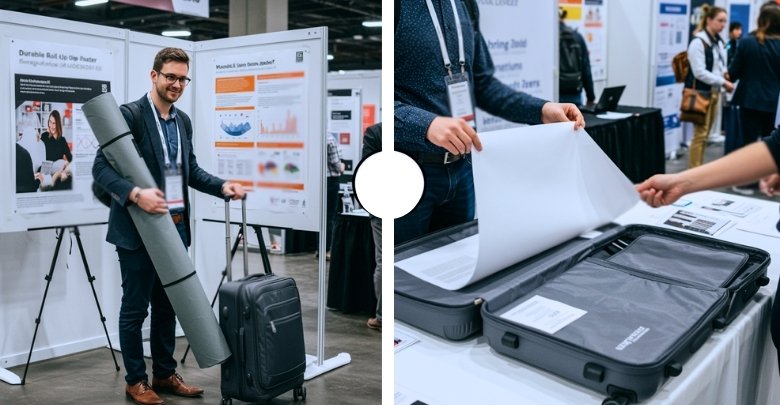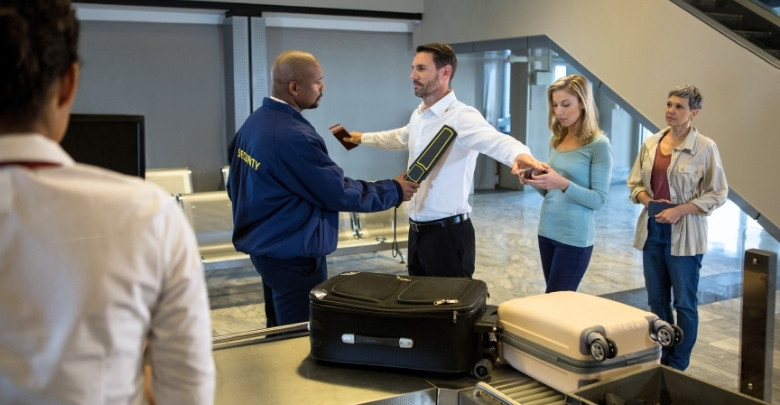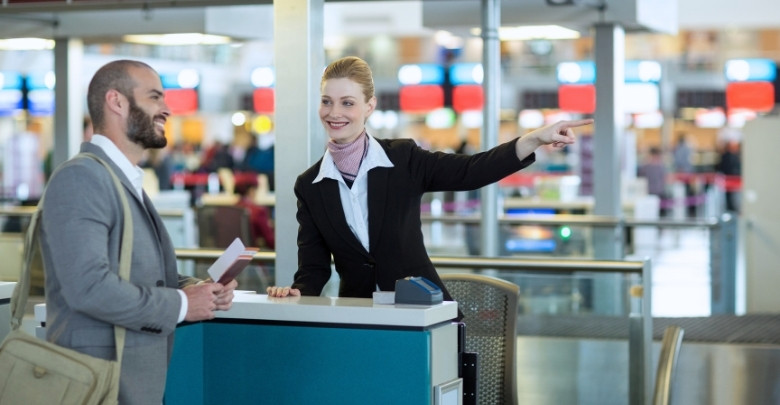A conference poster is an essential part of many academic and professional events, representing your work or research. Whether it’s about your latest project or a major study, it needs to be presented neatly and professionally. However, when it comes to travel, a common concern arises: How do you carry a conference poster on a plane?
To carry a conference poster on a plane, choose a foldable fabric or a rolled paper poster. Use a solid tube or folder for protection. Always pack it in your carry-on, not checked baggage. Be prepared for security checks, and keep your poster safe during the flight and upon arrival.
Want to know more about how to keep it safe during your flight? Read on, and you’ll find all the important details you need for hassle-free travel.
How Do You Carry a Conference Poster on a Plane?
Taking a conference poster on a plane might seem challenging at first. You may be unsure of what to pack, how to carry it, and if it will stay safe. Don’t worry—it’s not as hard as it sounds. Let’s break it down step by step to help you figure it out:
1. Pick the Best Type of Poster
Posters are usually printed on either paper or fabric. Fabric posters are better for travel because you can fold them. Paper posters need to be rolled and put in a tube. Think about how long your flight is and how easy it will be to carry. If you don’t like folding, paper might still work, but it needs more care. Choose the type that fits your trip and comfort.
2. Use a Strong Poster Tube or Folder
If you have a paper poster, get a strong tube made of plastic or hard cardboard. The tube will protect your poster from bending or tearing. Make sure the tube has a cap on both ends and a strap to carry it easily. You can also use a flat poster folder if your poster is fabric. Label your tube or folder with your name and phone number in case it gets lost. A good tube or folder keeps your poster safe the whole time.
3. Print a Backup Copy
It’s a smart idea to carry a backup copy of your poster. You can save the file on a USB drive or online in Google Drive or Dropbox. If something happens to your main poster, you can print it again at the conference or nearby. Some hotels or copy shops offer printing services for upcoming conferences and events. This saves you from panic if your poster gets damaged or lost. Always prepare for problems before they happen.
4. Check Airline Rules Before You Fly
Different airlines have different rules for carry-on items. Some allow poster tubes as personal items, while others may count them as a carry-on. Look at your airline’s website or call them to ask. If your poster is too big, you may have to pay extra or check it in. Knowing the rules early helps you avoid stress at the airport. Always double-check before packing.
5. Pack the Poster Carefully
Roll your poster slowly and gently if it is paper. Don’t roll it too tightly or it might get creases. If it is a fabric poster, fold it along the printed lines to avoid wrinkles. Place tissue paper between the folds or rolls to add extra protection. Put it in the tube or folder and close it tightly. Make sure nothing heavy is placed on top of it in your bag.
6. Carry It On, Don’t Check It
Never put your poster in checked baggage because it might get lost or bent. Always take it with you in the plane cabin. If you are using a tube, hold it or place it in the overhead bin. A small poster folder might fit under your seat. Keep your eye on it during the flight to avoid damage. This way, your poster arrives in good shape.
7. Be Ready at the Security Check
You may be asked to open your tube or folder at airport security. Tell them it’s a poster for a school or work conference. Stay calm and polite if they want to check it. Keep your ID and ticket nearby so you don’t waste time. Being organized helps the check go faster. Give yourself extra time at the airport just in case.
8. Store It Safely Upon Arrival
When you reach your hotel or conference place, unpack your poster right away. Unroll or unfold it gently to remove any wrinkles. Lay it flat on a bed or table, or hang it up if you can. Don’t leave it near heat or water. This helps your poster stay clean and neat. A well-kept poster looks better during your presentation.
Significance of Conference Poster
In academic and professional circles, creating well-designed conference posters bridges the gap between complex research and accessible communication. They are visual summaries of research or projects, designed to capture attention and stimulate discussion. Here’s a closer look at their significance:
- Visual Summarization: Conference posters condense extensive research into a visually appealing, easily digestible format. They highlight key findings and data, making complex topics more approachable for a diverse audience.
- Engagement Platform: These posters encourage interaction, inviting viewers to ask questions and engage in discussions. This creates a dynamic environment for knowledge exchange and networking.
- Creative Expression: Designing a conference poster offers an opportunity for creativity, blending scientific data with graphical elements. This unique fusion attracts attention and enhances the understanding of the subject.
- Research Dissemination: Posters provide an effective way to disseminate research findings to a broader audience. They serve as an accessible medium for those not deeply versed in the specific field.
- Feedback Opportunity: Presenting a poster allows researchers to receive immediate feedback from peers and experts. This interaction can lead to valuable insights and future collaboration opportunities.
- Educational Tool: They serve as educational tools, especially for students and early-career researchers. Posters help in developing skills in summarizing research and presenting it effectively.
Conference posters thus stand as pivotal tools in the landscape of academic and professional communication. They not only facilitate the dissemination of information but also foster a vibrant community of learning and collaboration.
How Can You Ensure Your Poster Stays Stable During the Flight?
When you don’t know how to keep a poster from moving or falling on a plane, carrying it can feel quite stressful. Flights often come with bumps, sudden stops, or tight storage spaces. If your poster isn’t packed or placed right, it might shift around or get damaged. Stick around and learn how to keep your poster steady the whole way.
Right Type of Bag
Using the right kind of bag makes a big difference. A strong poster tube with caps on both ends keeps it from sliding out. For flat posters, a firm portfolio case works even better because it doesn’t roll around. Make sure the bag isn’t too loose, so the poster doesn’t shift inside. A good fit means less movement and better safety.
Secure from Inside
If there’s space inside your tube or folder, add soft things like cloth or bubble wrap. This fills empty space and keeps the poster from sliding back and forth. You can also use rubber bands or soft clips to hold the poster in place. Just make sure they don’t leave marks or squeeze too hard. The idea is to keep everything from moving around.
Handle with Care
The way you carry your poster matters more than you think. Always keep it upright or flat—never hold it at a slant where it might slide. Don’t swing it or toss it in the car or on airport seats. If you’re waiting in line, gently rest it against your leg or bag. Carrying it gently helps it stay in one spot.
Store It Smartly
On the plane, look for a good spot where the poster won’t roll or fall. Place it flat under the seat or upright against the side of the overhead bin. Don’t shove it between bags, or it might twist. If you’re unsure, ask a flight attendant to suggest the safest place. Good storage helps your poster stay steady during takeoff and landing.
Watch for Movement
Planes often shake or tilt during the flight, so keep an eye on your poster. If you notice it moving, adjust it quickly before it slips. It’s better to check a few times than to find it bent later. Even small bumps can make things shift. A little attention goes a long way in keeping it still.
Use a Support Base
If your poster is rolled, place something solid at the bottom of your bag or under the poster. This keeps it from rolling around in open spaces. For flat posters, putting a thin book or board under it helps stop bending and keeps it balanced. Support from underneath makes everything more stable. Think of it like giving your poster a strong floor to stand on.
Types of Conference Posters You Can Carry With You
Conference posters are essential tools for sharing research and ideas engagingly and concisely. Posters for different types of conferences differ in content, design, and presentation to meet the specific needs and goals of each conference. Below, we explore different types of conference posters that are perfect for carrying around:
Roll-Up Posters
Roll-up posters are incredibly user-friendly, as they can be easily transported in a tube. Once at the conference, you simply unroll them for display. They’re made of durable material, resisting tears and creases. These posters also save space, perfect for crowded conference halls.
Fabric Posters
Fabric posters are gaining popularity for their lightweight and wrinkle-resistant qualities. They can be folded neatly into a suitcase, eliminating the need for a carrying tube. When unfolded, they retain a professional look without any creases. Their durability ensures repeated use without damage.
Tri-Fold Posters
Tri-fold posters offer a structured display with three distinct panels. They stand on their own, eliminating the need for additional support. These posters are easy to carry, fitting into most car trunks. The segmented design allows for an organized and impactful presentation of information.
Digital Posters
Digital posters provide a modern twist, often displayed on tablets or lightweight screens. They are perfect for interactive presentations and can be updated in real-time. Their portability is unmatched, fitting into most bags. Digital posters also reduce the need for printed materials, making them eco-friendly.
Laminated Posters
Laminated posters boast a protective layer, safeguarding against spills and smudges. This feature is ideal for busy conference environments. They maintain their quality over time, making them a good investment. The lamination also enhances color vibrancy, making your poster stand out.
Modular Posters
Modular posters consist of multiple small panels that can be easily assembled on-site. They offer flexibility in design and layout. Transporting them is hassle-free, as each panel is lightweight and compact. This type of poster is perfect for detailed presentations requiring a larger display area.
How to Pack a Poster in a Suitcase?
Taking a poster with you in a suitcase can feel a bit tricky, especially if you want it to stay smooth and neat. It’s easy to worry about creases, folds, or damage while you travel. But with a few simple procedures, you can pack your posters safely. Want to know the best ways to keep your poster looking great when you unpack it? Let’s check out the details below:
Choose How to Pack
First, think about your poster type. If it’s made of fabric, folding it gently along the crease lines works well. For paper posters, rolling is usually better to avoid hard folds. Don’t roll it too tight or fold it roughly, as that can cause wrinkles or tears. Pick the way that keeps your poster smooth and damage-free.
Use Protection
Once you decide how to pack your poster, add some protection around it. For rolled posters, a sturdy tube keeps them from getting bent or squished. You can find tubes made of hard plastic or thick cardboard. If you’re folding, use a flat folder or portfolio case to hold the poster steady. Adding a layer of tissue paper between folds or rolls helps avoid creases.
Pack It Carefully
When putting your poster in your suitcase, make sure it’s in a safe spot. Place it flat on top of your clothes or between soft items to stop it from moving around. Avoid putting heavy things on top that might press or bend it. If it’s rolled in a tube, make sure the tube fits snugly so it won’t roll inside the suitcase.
Handle With Care
Carry your suitcase gently to avoid sharp bumps or pressure on the poster. When packing, try not to squeeze your suitcase too full because that can crush the poster inside. If possible, keep your poster tube or folder with you as a carry-on to have more control over it during travel.
Unpack and Flatten
After you arrive, take out your poster quickly. If it’s rolled, unroll it gently and let it lie flat for a while to smooth out curls. For folded posters, unfold carefully and place something light on the corners if it doesn’t stay flat right away. This step helps your poster look neat and ready for use.
Customs Issues When Traveling With Conference Materials
Traveling for a conference sounds simple until you hit a few unexpected bumps at customs. Things like posters, handouts, or even equipment can raise questions at the airport. If you’re not ready, it can slow you down or cause stress. Here’s what might happen and how to handle it right.
Declaring Conference Items
Sometimes, customs wants to know what you’re bringing into their country. If you’re carrying posters, flyers, or display tools, they might ask what they’re for. You should always be honest and explain that it’s for a conference. If you don’t say anything and they find it, that can lead to trouble. It’s better to declare than to get stopped later.
Paperwork Trouble
Some countries need forms or special letters to let your items through. This is true if you’re bringing lots of printed materials or things you plan to hand out. Without the right papers, customs might hold your stuff. You can ask the event organizers if they provide any official documents. A simple paper can save a lot of time and worry.
Extra Fees
In some places, they might charge a fee for items you’re bringing in, even if they’re not for sale. These are called customs duties or import taxes. It feels unfair, but it’s part of their rules. Check before your trip if your country or airline warns about such charges. It’s better to be ready with extra money just in case.
Confusing Equipment
If you’re carrying things like projectors, stands, or even lights, customs might think you’re bringing them to sell. That can cause a delay if you don’t explain clearly. Sometimes it helps to show a return flight ticket and say you’re taking it all back with you. Having a list of what you packed can also help. The clearer you are, the faster it goes.
Language Problems
You may have trouble explaining what your stuff is for if you don’t speak the language. Customs officers may not understand right away, and that can lead to confusion. Try to keep a short note in their language explaining that you are attending a conference. You can also show an invitation or email that proves your reason for travel. A little effort can save a big delay.
Delayed Bags
Sometimes your conference materials are in your checked bag, and the bag gets delayed or held at customs. That means you might not have your items when you land. It’s smart to keep your most important things, like your poster, with you in your carry-on. Always label your bags with your contact info. That way, even if there’s a delay, they can reach you fast.
Things You Shouldn’t Bring
Some countries don’t allow certain printed images, types of paper, or topics. If your poster or materials include anything sensitive, you could get stopped. Always check the rules for the country you’re going to. Avoid including anything that might seem political or offensive. Playing it safe helps you avoid bigger problems.
What Should You Do if Your Poster Tube Exceeds the Airline’s Carry-on Size Limit?
It can be stressful when you find out your poster tube is too long to count as a carry-on. Airlines have size rules, and sometimes your tube just doesn’t fit them. That doesn’t mean you’re out of options. There are still ways to keep your poster safe—let’s look at what you can do:
Ask at the Counter
Before you panic, speak to the staff at the check-in desk. Sometimes they make exceptions, especially if your item is light and not dangerous. If they say yes, they might even place it in a safe spot on the plane. Always be polite and explain why you need to keep it close. A kind attitude goes a long way.
Use the Fragile Tag
If they say you have to check it in, ask them to mark it as fragile. This tells the baggage team to handle it with care. You can also write “Do Not Bend” on the tube with a marker. Add some bubble wrap inside for extra safety. This lowers the chance of it getting damaged.
Carry a Smaller Tube
You may want to consider getting a shorter, collapsible tube if you travel a lot. These are made for flying and fit within most size limits. You can roll your poster a bit tighter without hurting it. It’s a good choice for saving space. Plus, smaller tubes are easier to carry around.
Use a Poster Folder
Flat poster folders can be a great backup. They hold the poster flat and are usually allowed as a personal item. They’re easy to slide under the seat in front of you. Just be sure your poster fits without needing to be folded weirdly. It’s a simple way to avoid tube trouble.
Check Airline Rules Early
Always check your airline’s size rules before you even pack. Every airline is different, and knowing their rules helps you plan better. Some might allow a long tube if you don’t have a second bag. Others might charge you a small fee. It’s better to know than to be surprised at the gate.
Use a Shipping Option
If nothing works, you can ship your poster to your hotel or the conference site. It’s not free, but it keeps your poster out of airport problems. Use a trusted shipping company and pack it really well. Add tracking so you can see where it is. Just make sure it arrives before your event.
Keep a Backup
No matter what, always have a digital copy of your poster saved. You can carry it on a USB or save it online. If something happens to the tube, you can print a new one quickly. Some hotels or shops near the airport can help you print. A backup means less stress if things go wrong.
What to Do With Your Poster Once You Land?
Landing at your destination feels great, but your job isn’t over just yet. Your poster needs some attention after the flight so it stays clean, flat, and ready to present. A few small steps can make a big difference. Here’s what you should do once you get there:
Unpack It Quickly
Don’t leave your poster rolled up or packed for too long. As soon as you get to your hotel or place to stay, take it out of the tube or folder. The longer it stays packed, the more likely it is to curl or wrinkle. Unpacking early gives it time to flatten out. This simple step makes your poster look much better.
Find a Clean Spot
Look for a flat and clean surface like a table or a bed. Lay your poster out gently so it can relax from being rolled or folded. Don’t put it on the floor where it could get dirty or stepped on. Make sure the spot is dry and away from food or drinks. A safe spot helps avoid last-minute problems.
Weigh Down the Corners
If your poster doesn’t stay flat, place small books or other light objects on the corners. This helps it settle without needing to press it hard. Be careful not to use anything that can leave marks. After a few hours, your poster should look smooth. It’s a simple way to fix little curls.
Keep It Away from Heat
Avoid placing your poster near heaters, windows with direct sunlight, or warm lamps. Too much heat can make the paper curl or fade the colors. Store it in a cool, dry place if you’re not hanging it right away. Even fabric posters can get damaged from heat. Staying careful keeps your poster looking fresh.
Use a Hanger or Clip
If your hotel has a hanger with clips or pants hangers, you can gently hang your poster. This works great for fabric posters. Hanging lets gravity help smooth out any folds or soft creases. Just make sure the clips are soft and don’t pinch the edges. Hanging it up can save space and help it stay neat.
Keep It Safe Until Needed
Once your poster is flat and ready, put it somewhere it won’t be touched or moved too much. Avoid placing it near doors, bags, or suitcases. Let others know not to place things on top of it. If needed, place it back in the tube or folder right before you leave. Keeping it safe means fewer worries on presentation day.
Frequently Asked Questions
Many small questions come up when traveling with a conference poster. From packing tips to flight tricks, it helps to know what works best. Below are answers to common questions people often ask when preparing to fly with a poster.
Can I Fold a Laminated Poster for Travel?
No, folding a laminated poster is not a good idea. Laminated posters are thick and stiff, so folding them can cause cracks or permanent bends. Instead, roll them gently and place them in a sturdy tube for travel. This keeps the poster smooth and damage-free.
What’s the Lightest Way to Travel With a Poster?
The lightest way is to print your poster on fabric. Fabric posters can be folded and packed inside your carry-on bag without needing a heavy tube. They’re also wrinkle-resistant and don’t take up much space. This makes them ideal for air travel.
Can I Carry a Poster Without a Tube or Folder?
It’s not recommended to carry a poster without some kind of protection. Posters can easily bend, tear, or get dirty if left loose. If you don’t have a tube or folder, at least wrap it in clean paper or plastic. A proper case is always the safest choice.
Can I Bring a Poster Board on a Plane?
Yes, you can bring a poster board on a plane. Just make sure it fits the airline’s size rules for carry-on items. It’s best to carry it in a protective folder or tube to avoid damage. Always check with your airline beforehand to avoid any surprises at the airport.
How Early Should I Print My Poster Before Flying?
Try to print your poster at least a few days before your flight. This gives you enough time to check for printing errors and pack it properly. It also reduces stress in case something goes wrong. Always double-check your print before packing it.
Should I Label My Poster Tube?
Yes, always label your tube with your name, phone number, and email. If it gets lost at the airport, this makes it easier for staff to return it. You can also include a “Conference Material” note. A label adds an extra layer of security.
What’s the Best Poster Size for Flying?
A common size like 36×48 inches is usually manageable for air travel. Try to keep your poster under 42 inches on its longest side if you’re using a tube. Bigger posters may not fit in bins or under seats. Always check your airline’s carry-on size rules.
How Should I Handle Posters During Layovers?
During layovers, keep your poster with you at all times. Don’t leave it on seats or in corners where it might be forgotten. Hold it or place it gently across your lap or under a seat. Short layovers are fine, but long ones need more care.
Can I Carry Multiple Posters on a Plane?
Yes, but try to keep them in one tube or folder to save space. Carrying too many separate items might cause problems at security or with carry-on limits. Roll them together with tissue paper in between. This protects them from rubbing or creasing.
Should I Bring Poster Mounting Supplies in My Carry-On?
Yes, it’s smart to bring small items like clips, tape, or push pins. Put them in a clear plastic bag to show at security if asked. Avoid anything sharp that might not be allowed. Having these supplies ready helps during setup at the conference.
Conclusion
Traveling with a poster might sound tricky, but with the right plan, it’s actually pretty simple. A little care goes a long way in keeping your work safe and looking sharp. Whether it’s your first time flying with one or you’ve done it before, each step makes a difference.
From choosing the right material to packing it smartly and keeping it close during the flight, there are plenty of easy ways to stay prepared. Being calm, checking airline rules, and handling your poster gently can save you from last-minute stress. And don’t forget—unpacking it early is just as important as packing it right.
So, how do you carry a conference poster on a plane? You do it with care, smart thinking, and a bit of preparation. Follow these simple tips, and your poster will be ready to impress the moment you land.









